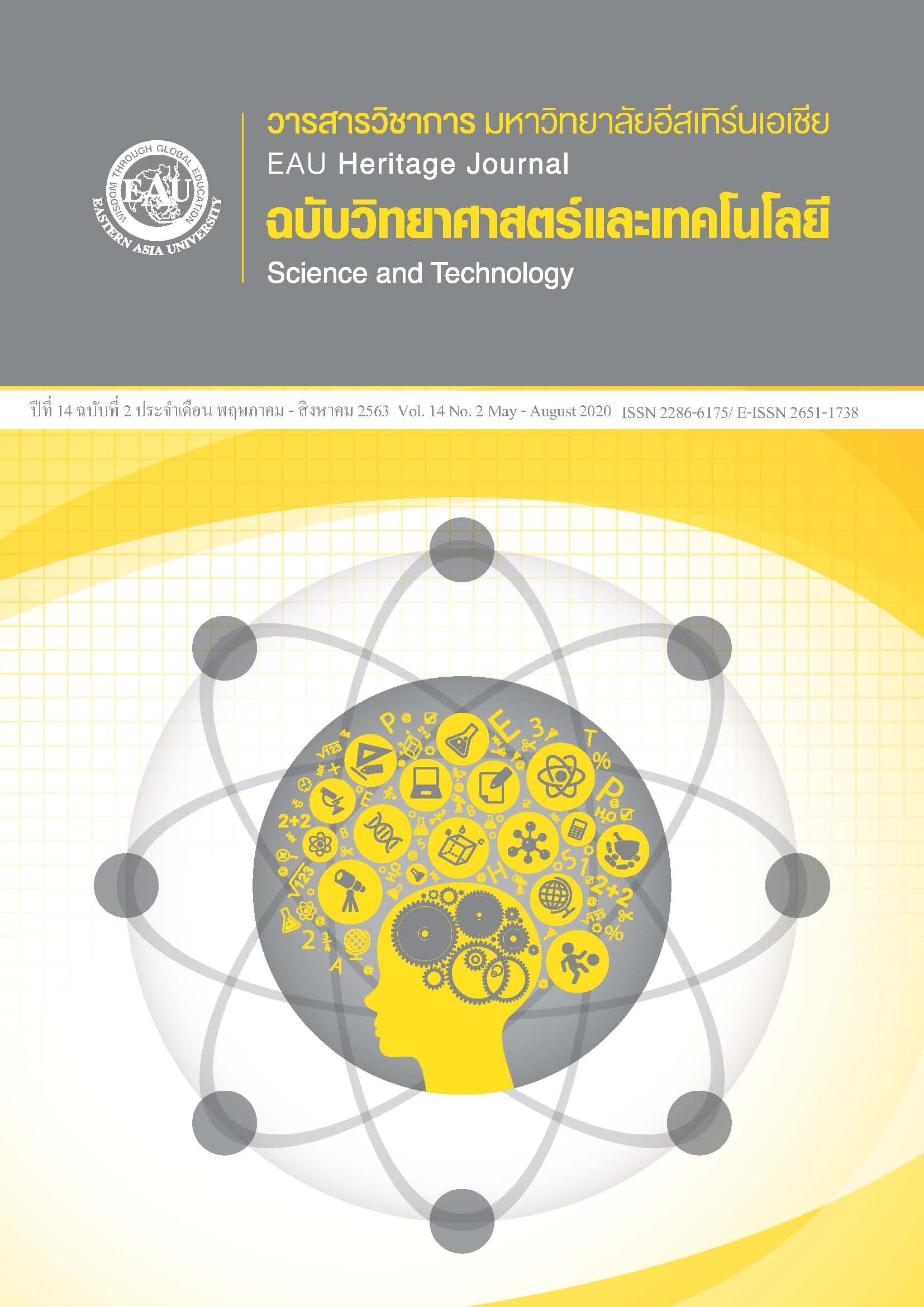การตั้งตำรับและการประเมินตำรับยาคีโตโคนาโซลนาโนอิมัลชัน
คำสำคัญ:
นาโนอิมัลชัน, คีโตโคนาโซล, ยาใช้เฉพาะที่บทคัดย่อ
ในการรักษาโรคเชื้อราที่ผิวหนังจะเริ่มจากการใช้ยาทาในบริเวณที่ติดเชื้อ ส่วนใหญ่ต้องใช้เวลาในการรักษานาน ซึ่งข้อดีของการใช้ยารูปแบบทา คือ ลดความเสี่ยงในการเกิดผลข้างเคียงจากการใช้ยา รวมทั้งลดโอกาสในการเกิดอันตรกิริยากับยาอื่น แต่ถ้าเป็นโรคเชื้อราที่ผิวหนังบริเวณกว้างหรือเรื้อรังจะต้องใช้ยารับประทานร่วมกับการใช้ยาทา การรักษาการติดเชื้อราที่ผิวหนังโดยใช้ยาทามักจะใช้เวลานานในการรักษา การพัฒนาตำรับยาโดยใช้ระบบนำส่งอาจช่วยเพิ่มประสิทธิภาพในการรักษาของยาได้มากขึ้น งานวิจัยนี้จึงมีจุดมุ่งหมายเพื่อพัฒนาตำรับยาคีโตโคนาโซลนาโนอิมัลชันเป็นยาทาภายนอก และศึกษาประสิทธิภาพในการต้านเชื้อราของตำรับ ในการเตรียมตำรับนาโนอิมัลชันชนิดน้ำมันในน้ำ (O/W) มีการใช้น้ำมัน Capyrlic/capric triglyceride และ isopropyl myristate และใช้ non-ionic surfactant ด้วยวิธีการเตรียมนาโนอิมัลชันแบบใช้พลังงานต่ำ โดยทำให้เกิดการกลับวัฏภาค (phase inversion) เพื่อให้ได้อนุภาคภายในขนาดเล็กที่สภาวะอุณหภูมิคงที่ และนำสูตรตำรับที่มีความคงสภาพ หลังจากเก็บไว้ที่อุณหภูมิ 30 และ 45 องศาเซลเซียส เป็นระยะเวลานาน 30 วัน มาประเมินประสิทธิภาพในการต้านเชื้อราบนอาหารเลี้ยงเชื้อ ผลการทดลองพบว่าตำรับคีโตโคนาโซล 0.5% w/w นาโนอิมัลชันที่พัฒนาขึ้น ประกอบด้วยน้ำมัน caprylic/capric triglyceride ต่อ สารลดแรงตึงผิวชนิดไม่มีประจุ ในอัตราส่วน (4:1) เมื่อเก็บไว้นาน 30 วัน มีขนาดอนุภาคอยู่ในช่วง 189.4+6.7 นาโนเมตร ที่อุณหภูมิ 30 องศาเซลเซียส และค่า zeta potential อยู่ในช่วง -28.4+3.4 มิลลิโวลต์ และยังพบว่าตำรับคีโตโคนาโซลนาโนอิมัลชันที่พัฒนาขึ้น มีฤทธิ์ในการต้านเชื้อ Candida albican. บนอาหารเลี้ยงเชื้อโดยวิธี Agar well diffusion มากกว่ายาครีมในท้องตลาด (2.0% w/w) อย่างมีนัยสำคัญทางสถิติ (p≤.05) ดังนั้นตำรับคีโตโคนาโซลนาโนอิมัลชันที่พัฒนาขึ้นนี้มีแนวโน้มในการต้านเชื้อราที่ผิวหนังได้อย่างมีประสิทธิภาพ
เอกสารอ้างอิง
Anton, N., & Vandamme, T. F. (2011). Nano-emulsions and Micro-emulsions: Clarifications of the critical differences. Pharmacy Research, 28(5), 978–985. doi: 10.1007/s11095-010-0309-1.
Balouiri, M., Sadki, M., & Ibnsouda, K, (2016). Method for in vitro evaluating antimicrobial activity: A review. Journal of Pharmaceutical Analysis, 6(2), 71-79. doi:10.1016/j.jpha.2015.11.005.
Gingor, S., Erdal, M. S., & Aksu, B. (2013). New formulation strategies in topical antifungal therapy. Journal of Cosmetics Dermatological Sciences and Applications, 3, 56-65.
Junyaprasert, V. (2009). Nanotechnology: Skin delivery of drugs and cosmetics. Bangkok: Prachachon Co., Ltd. (in Thai)
Luplertlop, N., & Suwanmanee, S. (2013). Dermatophytosis: from bench to bedside. Journal Tropical Medicine, 36, 75-87. Available online at www.ptat.thaigov.net. (in Thai)
Martin, A. G., & Kobayashi, G. S. (1999). Superficial fungal infection: Dermatophytosis, Tinea ungium, piedra. In I. M. Freeberg, & A. Z. Eisen, Fitzpatrick’s dermatology in general medicine. New York: McGraw-Hill .
Patel, R. R., Patel, Z. K., Patel, K. R., & Patel, D. R. (2014) Formulation and evaluation of Micro-emulsion based gel of Ketoconazole. International Journal of Universal Pharmacy and Biology Science, 3(2), 93-111.
Patel, H. C., Parmar, G., Seth, A. K., Patel, J. D., & Patel, S. R. (2013). Formulation and evaluation of o/w Nanoemulsion of Ketoconazole. Pharma Science Monitor, 4(4 Supp. 1), 338-351. http://pharmasm.com/current_issue2.php?archive=39
Petranyl, G., Meingassner, J. G., & Mieth, H. (1987). Antifungal activity of the Allylamine Derivative Ierbinafine in vitro. Antimicrobial Agents and Chemotherapy, 31(9), 1365-1368. doi: 10.1128/aac.31.9.1365
Rangsimawong, W., & Ngawhirunpat, T. (2014). Nanoemulsions in transdermal drug delivery system. The Thai Bulletin of Pharmaceutical Sciences, 9(2), 46-61. (in Thai)
Sadurni, N., Solans, C., Azemar, N., & Garcia, M. J. (2005). Studies on the formation of o/w Nanoemulsions by Low-energy Emulsification Methods suitable for pharmaceutical applications. European Journal of Pharmaceutical Sciences, 26(5), 438-445. doi: 10.1016/j.ejps.2005.08.001
Santos, D. A., & Hamdan, J. S., (2005). Evaluation of broth Microdilution Antifungal susceptibility testing conditions for Trichophyton rubrum. Journal of Clinical Microbiology, 2005, 1917–1920.
Skiba, M., Lahiani, M. S., Marchais, H., Duclos, R., & Arnaud, P. (2000). Stability assessment of Ketoconazole in aqueous formulations. International Journal of Pharmaceutics, 198(1), 1-6. doi:10.1016/s0378-5173(99)00279-3.
Tassaneeyakul, W. (2016), Antifungal Agents. Khon Kaen: Department of Pharmacology, Faculty of Medicine, Khon Kaen University. (in Thai)
Tebaidi, D. C. (2014). Development of Ketoconazole-based Nanoemulsions stabilized by Polymeric surfactant. XIV.SLAP/XII CIP, October 12-16th (pp. 1-3). Porto de Galinhas, Brazil: Associação Brasileira de Polímeros
Wooster, J., Golding, M., & Sanguansri, P. (2008). Impact of oil type on Nanoemulsion formulation and ostwald ripening stability. Langmuir, 24(22), 12758-12765. doi: 10.1021/la801685v.







